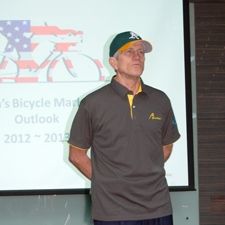TAIPEI, Taiwan (BRAIN) Mar 8 2012 3:00 PM MT—Change is afoot in the U.S. market, and a statistical analysis prepared for the annual A-Team meeting during the Taipei Cycle show Thursday offered a hint of what suppliers and retailers should consider over the next few years. (Click on link above to download the PDF newsletter with more coverage from the Taipei Cycle show.)
Specialized’s Bob Margevicius, asked to prepare the analysis, sorted through a variety of statistical reports to paint a picture of the changes the U.S. market is now undergoing.
Some key highlights that Margevicius cited include:
• Bicycling isn’t for kids anymore. Kids riding bikes has dropped more than 20 percent between 2000 and 2010, while the number of adults who ride has increased slightly.
• It’s enthusiasts who drive growth. More than 21.8 million adults rode a bike 109 days or fewer in 2010, about the same number as in 2000. But an additional 3.4 million rode 110 days or more, and the number of frequent cyclists increased 12 percent over the decade.
• Most women have little interest in cycling. About 10.2 million women rode 109 days or fewer in 2010, a decrease of 13 percent since 2000. But female enthusiasts are on the rise. The number of women who rode 110 days or more exceeded 1.3 million and increased 8 percent during the decade. At the same time, the number of men who ride that frequently jumped 15 percent.
• Older riders ride more often. Participation falls off after age 55, particularly among women. But male riders who belong to the enormous baby-boom generation show few signs of slowing down. In fact, riding days for men tend to increase after they reach age 65.
• Youth equals diversity. Most children in America’s largest cities and states no longer have an Anglo-American cultural background. But more than 85 percent of bicycle riders are non-Hispanic and white. The future viability of the U.S. industry will depends on finding ways to appeal to black, Hispanic and Asian families. That’s why it’s of critical importance to make urban and suburban areas safe and bicycle-friendly.
In the short term, though, the U.S. market is currently enjoying a sales boost as mild weather dominated most parts of the country this winter, Margevicius said. And with gas prices rising, and the threat of $5-a-gallon gasoline hanging over the nation, suppliers and retailers could see a surge in sales, particularly for repairs.
However, Margevicius noted that high gas prices are a two-edged sword. As consumers pour more of their dollars into their gas tanks, they will have less disposable income available to spend on consumer goods—and that includes bikes.
Still, he pointed out, two other factors could help keep sales moving along at a brisk pace. First, it’s an election year and, historically, bicycle sales tend to increase during the election cycle. And the upcoming Olympics also tend to give sales a boost.




